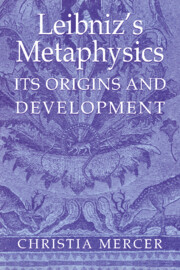Book contents
- Frontmatter
- Contents
- Acknowledgments
- References to Leibniz's works
- Introduction: first truths and half truths
- PART ONE METAPHYSICS OF METHOD
- PART TWO METAPHYSICS OF SUBSTANCE
- PART THREE METAPHYSICS OF DIVINITY
- PART FOUR METAPHYSICS
- 7 Matter, passivity, and panorganic vitalism, 1670–71
- 8 Phenomenalism and Preestablished Harmony, 1671
- 9 Preestablished Harmony, late 1671–early 1672
- 10 Final steps toward the mature philosophy, 1672–79
- Conclusion: the truth behind the First truths
- Appendix I (Not exactly) First truths
- Appendix II Leibniz's original assumptions
- Bibliography
- Index Locorum
- Index
8 - Phenomenalism and Preestablished Harmony, 1671
from PART FOUR - METAPHYSICS
Published online by Cambridge University Press: 12 March 2010
- Frontmatter
- Contents
- Acknowledgments
- References to Leibniz's works
- Introduction: first truths and half truths
- PART ONE METAPHYSICS OF METHOD
- PART TWO METAPHYSICS OF SUBSTANCE
- PART THREE METAPHYSICS OF DIVINITY
- PART FOUR METAPHYSICS
- 7 Matter, passivity, and panorganic vitalism, 1670–71
- 8 Phenomenalism and Preestablished Harmony, 1671
- 9 Preestablished Harmony, late 1671–early 1672
- 10 Final steps toward the mature philosophy, 1672–79
- Conclusion: the truth behind the First truths
- Appendix I (Not exactly) First truths
- Appendix II Leibniz's original assumptions
- Bibliography
- Index Locorum
- Index
Summary
Sometime between May and November of 1671, Leibniz invented Preestablished Harmony. It did not come to him suddenly as the ultimate truth in metaphysics; rather, it grew gradually out of his attempt to solve the theological and philosophical problems that most interested him. As he reflected on topics in ethics, law, theology, physics, and metaphysics, he used materials from his Metaphysics of Substance and Metaphysics of Divinity to compose solutions to the prominent problems that arose. Preestablished Harmony resulted from the convergence of these solutions. This elaborate metaphysical doctrine was the most elegant way to solve a diverse group of difficult problems, to capture the rationality and goodness of God, and to combine ancient and modern ideas. Obviously there are no passages in which Leibniz is both clear and explicit about this weighty metaphysical commitment: if there were such texts, then scholars would have recognized its early development long ago. But when a thorough survey of the writings of 1671 is made within the context of the sundry problems that concerned him, there emerges convincing evidence that by the end of 1671, Leibniz had accepted the doctrine.
In 1671, Leibniz wrote a number of letters to some of the most prominent intellectuals in Europe and several series of notes on topics as diverse as justice, resurrection, refraction, solidity, and the Trinity. Many of these texts are enormously difficult.
- Type
- Chapter
- Information
- Leibniz's MetaphysicsIts Origins and Development, pp. 300 - 344Publisher: Cambridge University PressPrint publication year: 2001

